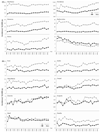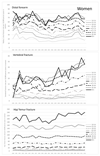Secular trends in fracture incidence in the UK between 1990 and 2012
- PMID: 27283403
- PMCID: PMC5035540
- DOI: 10.1007/s00198-016-3650-3
Secular trends in fracture incidence in the UK between 1990 and 2012
Abstract
We studied sex-specific incidence rates in a population 50 years or older in the UK. In the period of 1990-2012, the overall rate of fracture did not change, but there were marked secular alterations in the rates of individual fracture types, particularly hip and spine fractures in the elderly.
Introduction: There is increasing evidence of secular changes in age- and sex- adjusted fracture incidence globally. Such observations broadly suggest decreasing rates in developed countries and increasing rates in transitioning populations. Since altered fracture rates have major implications for healthcare provision and planning, we investigated secular changes to age- and sex-adjusted fracture risk amongst the UK population aged 50 years or above from 1990 till 2012.
Methods: We undertook a retrospective observational study using the Clinical Practice Research Datalink (CPRD), which contains the health records of 6.9 % of the UK population. Site-specific fracture incidence was calculated by calendar year for men and women separately, with fracture type categorised according to ICD-9 classification. Linear regression analysis was used to calculate mean annualised change in absolute incidence. For presentational purposes, mean rates in the first 5 years and last 5 years of the period were calculated.
Results: Overall fracture incidence was unchanged in both women and men from 1990 to 2012. The incidence of hip fracture remained stable amongst women (1990-1994 33.8 per 10,000 py; 2008-2012 33.5 per 10,000 py; p trend annualised change in incidence = 0.80) but rose in men across the same period (10.8 to 13.4 per 10,000 py; p = 0.002). Clinical vertebral fractures became more common in women (8.9 to 11.8 per 10,000 py; p = 0.005) but remained comparable in men (4.6 to 5.9 per 10,000 py; p = 0.72). Similarly, the frequency of radius/ulna fractures did not change in men (9.6 to 9.6 per 10,000 py; p = 0.25), but, in contrast, became less frequent in women (50.4 to 41.2 per 10,000 py; p = 0.001). Secular trends amongst fractures of the carpus, scapula, humerus, foot, pelvis, skull, clavicle, ankle, patella, and ribs varied according to fracture site and sex.
Conclusion: Although overall sex-specific fracture incidence in the UK population 50 years or over appears to have remained stable over the last two decades, there have been noticeable changes in rates of individual fracture types. Given that the impact of a fracture on morbidity, mortality, and health economy varies according to fracture site, these data inform the provision of healthcare services in the UK and elsewhere.
Keywords: Epidemiology; Fracture; Incidence; Osteoporosis; Secular trends.
Conflict of interest statement
statement R.Y. van der Velde, C. E. Wyers, E.M.Curtis, P. P. M. M. Geusens, J. P. W van den Bergh, F. de Vries, C. Cooper , T. P. van Staa and N. C. Harvey declare that they have no conflict of interest.
Figures



References
-
- Cooper C, Campion G, Melton LJ. Hip fractures in the elderly: a world-wide projection. Osteoporos Int. 1992;2(6):285–289. - PubMed
-
- Gullberg B, Johnell O, Kanis JA. World-wide projections for hip fracture. Osteoporos Int. 1997;7(5):407–413. - PubMed
-
- Hernandez JL, Olmos JM, Alonso MA, Gonzalez-Fernandez CR, Martinez J, Pajaron M, Llorca J, Gonzalez-Macias J. Trend in hip fracture epidemiology over a 14-year period in a Spanish population. OsteoporosInt. 2006;17(3):464–470. - PubMed
Publication types
MeSH terms
Grants and funding
- MR/K006665/1/MRC_/Medical Research Council/United Kingdom
- MC_U147585827/MRC_/Medical Research Council/United Kingdom
- MC_PC_13042/MRC_/Medical Research Council/United Kingdom
- 21231/ARC_/Arthritis Research UK/United Kingdom
- 201222/Z/16/Z/WT_/Wellcome Trust/United Kingdom
- MC_U147585819/MRC_/Medical Research Council/United Kingdom
- MC_UP_A620_1014/MRC_/Medical Research Council/United Kingdom
- G0400491/MRC_/Medical Research Council/United Kingdom
- MC_U147585824/MRC_/Medical Research Council/United Kingdom
- 10/33/04/DH_/Department of Health/United Kingdom
- MC_UU_12011/1/MRC_/Medical Research Council/United Kingdom
LinkOut - more resources
Full Text Sources
Other Literature Sources
Medical

